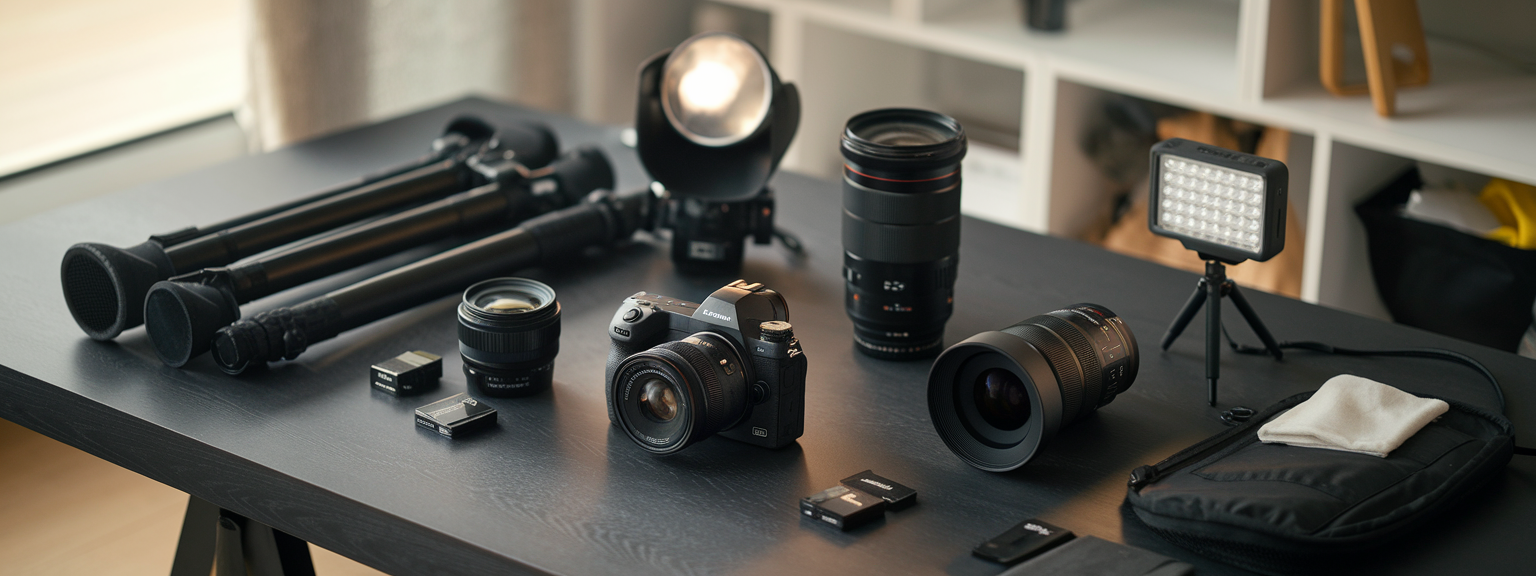Top Photography Gear Essentials Every Photographer Must Have

Photography is more than a creative pursuit—it is a visual language that requires both talent and the right tools. While a photographer’s vision and creativity are paramount, the correct equipment plays a crucial role in achieving professional results. This guide explores the Photography Gear Essentials that form the backbone of every successful photographer’s kit. From must-have camera gear to essential photography equipment like lenses, tripods, lighting, memory cards, and protective bags, you will learn how to build a complete photographer toolkit tailored to your style and needs.
📝 Step-by-Step Guide: Photography Gear Essentials for Beginners and Pros
Step 1: The Camera Body
Your camera is the foundation of your kit. Choosing between DSLR and mirrorless bodies is essential.
- DSLR Cameras – Durable, versatile, and excellent for all-around photography (e.g., Canon EOS 90D, Nikon D7500).
- Mirrorless Cameras – Compact, lightweight, with advanced autofocus and video functions (e.g., Sony A7 IV, Canon EOS R6).
Step 2: Essential Lenses
Lenses define image quality and creative versatility. Some must-have lenses include:
- 50mm f/1.8 – Great for portraits and low-light photography.
- 24-70mm f/2.8 – Perfect all-purpose zoom for events, travel, and landscapes.
- 70-200mm f/2.8 – Ideal for sports, wildlife, and ceremonies.
- Macro Lens – Required for detail-rich close-ups.
Step 3: Reliable Tripod
A tripod ensures sharpness during long exposures and stability in challenging conditions.
Step 4: Lighting Equipment
Good lighting is critical. Essential tools include portable LED panels, external flashes, softboxes, diffusers, and reflectors. Together, they provide flexibility to shape light in studio or outdoor settings.
Step 5: Memory Cards and Storage
Photography requires secure, high-speed storage. UHS-II SDXC cards ensure fast writing speeds, while SSD drives provide reliable backup options.
Step 6: Camera Bag
A good camera bag keeps equipment safe, organized, and accessible. Choose weatherproof designs for outdoor shoots, backpacks for travel, or messenger bags for quick access in urban sessions.
Step 7: Key Accessories
- Spare batteries and chargers
- Lens cleaning kits
- Lens filters (UV, polarizers, ND)
- Remote shutter releases
📌 Practical Applications: Photography Gear Essentials in Real-World Scenarios
Wedding Photography
Requires fast lenses, dual memory cards, and speedlights to adapt to varying light conditions.
Landscape Photography
Wide-angle lenses, sturdy tripods, and ND filters are essential for sharp panoramic images.
Sports and Wildlife Photography
Telephoto lenses, monopods, and rapid burst memory cards provide the flexibility to capture fast-moving subjects.
💡 Tips & Tricks: Photography Gear Essentials to Improve Your Shots
- Always carry extra memory cards and batteries to avoid downtime during shoots.
- Use lens hoods to reduce glare and physical damage risk.
- Employ reflectors to enhance natural lighting in portrait photography.
- Clean lenses before major shoots for best image clarity.
- Balance your kit—take only what you will realistically use.
📸 Sample Scenario
Imagine documenting an outdoor wedding. You carry a Sony A7 IV, a 24–70mm for group shots, a 50mm prime for portraits, and a 70–200mm for distant subjects. A portable flash illuminates dim reception areas, while a reflector improves daylight portraits. Dual memory cards provide backup, and a weather-sealed backpack keeps everything safe.
✅ Key Do’s for Effective Usage
- Do format memory cards regularly to prevent data issues.
- Do keep lenses spotless before important projects.
- Do optimize your bag’s weight for comfort and efficiency.
- Do test equipment in advance before significant shoots.
❌ Common Mistakes to Avoid
- ❌ Carrying too much unnecessary gear, causing fatigue.
- ❌ Relying on cheap off-brand batteries that may harm your camera.
- ❌ Ignoring lens quality in favor of expensive bodies.
- ❌ Using built-in flashes instead of learning lighting techniques.
🔄 Troubleshooting & FAQs
What is the most important gear for beginners?
A versatile entry-level DSLR or mirrorless model with a standard zoom lens (18-55mm) or a 50mm prime provides an excellent foundation.
How many lenses do I need to start?
Two lenses—one standard zoom and one prime—are sufficient at the beginning. Add others as your specialization grows.
Which memory cards are ideal?
UHS-II SDXC cards or CFexpress cards (for modern cameras) are best for high-resolution files and rapid shooting.
How can I improve lighting affordably?
Position subjects near windows, use reflectors, and supplement with budget LED lights. Thoughtful light placement enhances quality without high cost.
What kind of tripod should I buy?
Travel photographers benefit from lightweight carbon fiber tripods, while studio shooters should choose durable, heavy-duty options.
🖼️ Bringing It All Together
Building your photography gear essentials is a gradual process. Begin with your camera body, pair it with a versatile lens, and expand by adding lighting, tripods, accessories, and protective storage as your skills progress.
With the right gear, you not only make your work more efficient but also unlock your creative capacity. Every piece of essential equipment adds capability, enabling you to shoot more confidently and professionally.
Visit our Photography Content Hub
Smart Resize by SmartLink Basics iPhone or iPad app
“`


![[Breathtaking Landscape Photography Sunrise] [Sunrise over a mountain valley with wildflowers in the foreground — landscape photography showing golden-hour light and wide-angle composition.]](https://lenslesson.com/wp-content/uploads/2025/12/landscape-photography-breathtaking-sunrise-scene.png)
![[Level Up Your Skills Workspace] [Person at desk using laptop and notebook to level up your skills]](https://lenslesson.com/wp-content/uploads/2025/12/level-up-your-skills-planning-workspace.png)
![[Daily Creative Inspiration Journaling] [Person journaling at a sunlit desk capturing daily creative inspiration with a notebook and coffee.]](https://lenslesson.com/wp-content/uploads/2025/12/daily-creative-inspiration-journaling-ideas.png)
![[Post Processing Essentials Demo] [Photographer editing images on a monitor demonstrating post processing essentials workflow]](https://lenslesson.com/wp-content/uploads/2025/12/post-processing-essentials-overview.png)
![[Stunning Images Lighting Composition] [Photographer adjusting studio lights for Stunning Images during a portrait session.]](https://lenslesson.com/wp-content/uploads/2025/12/advanced-stunning-images-lighting-composition-editing.png)